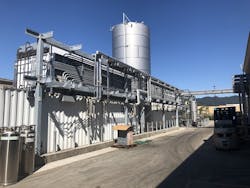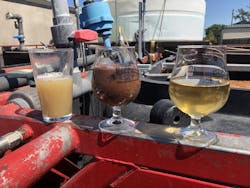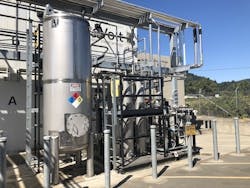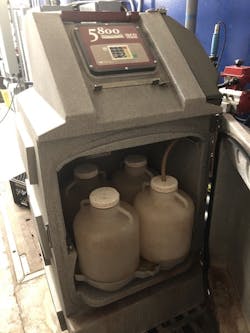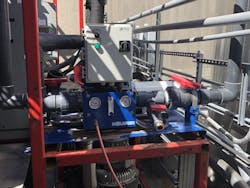Benefits Bubble Up: Wastewater Treatment
Bob Crossen is senior managing editor for Industrial Water & Wastes Digest. Crossen can be reached at [email protected].
What makes Bear Republic Brewing Company special is just how conscious its chief operating officer and master brewer is of water’s impact on the business and its local community.
Bear Republic was established in Sonoma County, California, in 1995 by the Norgrove family, and opened its first brew pub in January of 1997 in Healdsburg, California. In November of that year, Peter Kruger was hired to the company, launching his career path to his current position as Bear Republic Brewing Company master brewer and chief operating officer.
At the time he was hired, Kruger said the wastewater from the beer making process was sent through the sewer system to the municipal wastewater treatment plant.
“This was the golden age of municipalities viewing brew pubs as quaint businesses with minimal industrial impact,” Kruger said, adding that Bear Republic grew rapidly in that location and in 2000, purchased a distressed brewery in the region. “And we were able to grow both locations. From the first year of production of 1,000 kegs worth of beer to in 2005, we got up to about 20,000 kegs worth of beer out of those two locations that by that point had consolidated back to Healdsburg.”
This growth continued year-over-year with 30% to 40% growth annually for several years. To keep up with demand, the company established a production facility in Cloverdale, California, in 2005. Peak production was around 160,000 kegs of beer in one year.
Naturally, this gigantic increase in production over time began to stress the local wastewater treatment plant in Cloverdale, where the city’s population is around 8,000. Kruger said the brewery followed its industrial discharge permit and continued to scale until he got a call from the city of Cloverdale about the increased stress on its systems.
BOD Concentration Grows & Strains City Plant
Immediately, Bear Republic started conversations with the city to find a means to reduce the strain on the city’s system so as to maintain good relations with the municipality as well as the community.
“Our intention is always to be good neighbors,” Kruger said. “And we came up with a plan to reduce our BOD loading to the city.”
Kruger said at one point the brewery was discharging 50% of the capability of the plant. Brewery wastewater has an extremely high concentration, which was only made stronger as Bear Republic became more conscious of its water use during periods of drought. The less water it used, the higher the concentration of the waste grew. Kruger said the brewery’s BOD discharge is roughly 13,000 to 15,000 milligrams per liters.
“It’s very, very, very high strength compared to municipal waste,” Kruger said.
Kruger said the brewery started by trucking three 6,000-gallon trucks of the waste from the Cloverdale brewery location to a facility in Oakland roughly 90 miles away one-way. This solution, he said, was simply unsustainable for many reasons, and Bear Republic eventually partnered with Cambrian Innovation to install two anaerobic reactors on site. Thus began a foray into the world of wastewater treatment for Kruger, who majored in history and is a brewer by trade.
Breaking Down the Current Treatment Train
Kruger said there are two discharge streams for Bear Republic. One lateral is for the blackwater, which is sent straight to the city, while the other lateral sends the brewery wastewater through a separate line where it enters a lift station to begin its journey through the brewery’s wastewater treatment process.
Kruger said the next step for the water after being pumped through the lift station is its arrival to a custom tank with several steps. First in that step is a drum strainer that removes core solids. The strained water then dumps into a 1,000-gallon lift tank, where the system injects a coagulant into the water before running through a lamella clarifier—also known as an inclined plate settler, and a closed radial settler.
“Those two drop sludge into a 4,500-gallon sludge tank,” Kruger said, “that we then feed directly to the MBR for thickening and reduction.”
The clear water running off the initial treatment train runs to another lift station, Kruger said, where it enters a 50,000-gallon equalization tank, which holds around two and a half days worth of wastewater. This water then goes through the headworks of the anaerobic digester where it is pH-adjusted and tempered up to around 98ºF in a 1,000-gallon tank. A micro nutrient, he said, is injected at this stage for deficiencies in the wastewater, particularly cobalt, which ultimately aids the MBR. The water then enters a 20,000-gallon anaerobic digester before it is passed to a second anaerobic digester.
“We originally had those in parallel, but we changed them to running in series because it lengthened the train,” Kruger said, “and we were really able to get the right bacteria in the right place.”
When the water enters the anaerobic reactors, Kruger said the BOD is around 13,000 to 15,000 mg/L, and after passing through both anaerobic tanks, it reduces by around 45% to around 8,000 mg/L BOD. This wastewater can then run directly to the city, or it can run to the MBR to loop through again.
Bear Republic has a wastewater entitlement of 364 pounds per day, and Kruger said there is no reduction in fees if the brewery falls under that cap on its wastewater entitlement. As such, he said the operators aim to reach 75% of its entitlement each day to provide for “wiggle room” should it be needed.
“We’re balancing the blend of wastewater from the anaerobic digesters versus the MBR to come up with a final of total pounds per day,” Kruger said. “Coming off of the MBR, we’re non-detect on BOD. It really is less than 3 coming off.”
The wastewater at the end of the anaerobic stage runs through an effluent monitoring station to measure pH and temperature. An auto-sampler is also connected to this monitoring station, which helps the brewery ensure the quality of its effluent and verify its samples with the city when required. If it catches that the pH or temperature is off, it reroutes the waste back to the start of the entire treatment process.
“I think per barrel of production, we probably have the most complicated wastewater plant in the world,” Kruger said with a laugh.
The Growing Pains of a Growing Plant
At the start of the journey to the full treatment train, Kruger said building the two anaerobic digesters for the treatment at Bear Republic was almost a two-year project. He said the system was also designed to siphon off the biogas for combined heat and power, as well at that time. After installing the membrane bioreactor (MBR), Kruger said the system was at a point that the brewery could finally stop trucking its waste every day. He did, however, run into another problem.
“Because our loading is so high, the system did not receive enough oxygen, basically,” Kruger said. “So we had all the issues that go with under-oxygenated MBR: nocardia growth, and foaming, and poor treatment, and blinding of the membranes and all that.”
Kruger said he researched some ways to solve this problem and he learned of Moleaer, which specializes in nanobubble generators. As a test, Kruger initiated a “try before you buy” with Moleaer to see how one nanobubble unit would help improve the oxygenation of the MBR, so he and his team fed the unit pure oxygen and connected it to the cascading MBR.
“When I did the rate of return for the system, we basically ended up saving $36,000 per year for OpEx,” Kruger said. “We were able to stabilize the MBR because the principle of that system is that those bubbles are so small that they are not buoyant so they stay in the liquid.”
Bear Republic was trying to get more treatment out of the same tanks it was already using. The limiting factor at that time, he said, was the amount of oxygen that the liquid will hold. That is precisely what the nanobubble equipment did for his system.
Kruger had used traditional blowers prior to installing the system from Moleaer, but he said that on hot days the compression from the blowers could actually cook the bacteria in the treatment process. The pure oxygen with the new system, he said, is decompressing, so heat issue is no longer a problem. The original blowers were also not properly sized. He had three 20 horsepower blowers at first installation.
“The blowers they specified were oversized, and we were burning up a lot of them, and there was also an ongoing maintenance cost of replacing blowers every six to eight weeks,” he said.
After installing the nanobubble equipment however, Kruger said he was able to right-size the blowers to just one 15 horsepower blower, and its primary function is now mixing the tanks in the MBR rather than adding air to the system.
Reaping the Rewards of Risk
Kruger said he feels a deep obligation to the city to meet his discharge numbers, and because Bear Republic is a private entity, it can be quicker to maneuver and pivot to accept new technologies and try new ideas. Kruger is not bound by the same restrictions that municipal facilities are.
“I don’t have the same budgetary constraints as a city would,” Kruger said. “For example, the lamella we put in, we purchased that equipment used and threw it in line because we thought we could get a little bit better quality sludge.”
That lamella clarifier was purchased on a Friday and installed by the following Tuesday. Another example is the MBR, which was purchased and installed in a seven-week window when it was first set up. And Kruger is not finished tinkering with the system either.
His next steps include using some of the treated water for washing and landscaping to make each drop go that little bit further. And he is also interested in pushing the boundaries on potable reuse beer, but that will take some regulatory work before it becomes a reality.
